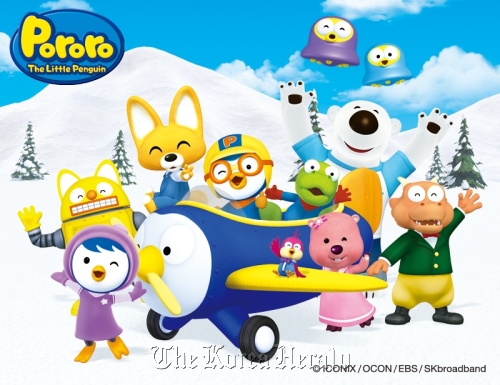South Korean animator Choi Jong-il knew he had a hit on his hands when Pororo the penguin hopped onto TV screens back in 2003.
Choi’s previous creations had failed to grab the undivided attention of his 6-year-old son and his son’s friends.
That all changed when the mischievous but affectionate blue and white penguin, sporting aviator glasses and a flying helmet, made his debut.
“The kids’ eyes were glued to the TV ... they never touched other toys as long as Pororo was on,” Choi told AFP in an interview.
Pororo, whose dream is to fly, has taken off big-time since then. In South Korea he has been dubbed the “children’s president” and his image appears on everything from cell phones to chopsticks.
Iconix, which Choi started in 2001 with six employees, has grown into one of the nation’s biggest animation studios with two subsidiaries and 160 workers.
Pororo has been sold to 110 countries and helped Iconix garner 27 billion won ($25 million) in sales last year.
Sales will grow to 38 billion won by the end of this year thanks to rising popularity overseas, particularly in China and Southeast Asia, Choi said.
Korean animators have talent and experience. In South Korea, they helped bring the Simpsons to life along with SpongeBob and other characters.
And a studio in hard-line communist North Korea, working as a subcontractor, helped flesh out Pororo.
“They did a pretty good job ... North Korea actually does a lot of animation subcontracting jobs, especially European countries like Italy,” Choi said.
 |
Kids animation Pororo (ICONIX/OCON/EBS/SKbroadband) |
But the collaboration fizzled out due to difficulties in phone calls and other communications across the divided peninsula.
In South Korea, a lack of investment has made it harder for animators to progress beyond being subcontractors, said Stella Suh, director of the animation industry team at the state-run Korea Creative Content Agency.
“South Korea has top-class world capability in animation production, but creating independent animation films is all about funding,” she said.
“The government has offered some financial aid but it’s hardly enough. Many (animators) still find it so difficult to find any major source of funding to kick start a new project.”
Thanks to Pororo, Iconix is the exception.
“Going global is inevitable given the small size of the domestic market ... I think our overseas sales will outpace our domestic sales by 2020,” Choi said.
His creed was to create a cartoon that offers nothing but fun.
“Most cartoons for pre-school children aim to educate them through different forms of lectures, typically delivered through adult characters squeezed in a story,” said the 45-year-old former advertising manager.
Pororo does not preach ― he just goes out and has fun in his Arctic setting with friends including Petty the female penguin, Poby the Polar bear, Crong the green dinosaur and Eddy the fox. There are no adults.
Internet chatrooms soon started to buzz with parents expressing gratitude that Pororo gave them a break from restless children.
The character was chosen as a goodwill ambassador for Visit Korea Year.
More than three million limited-edition stamp sets of Pororo were sold out in 10 days in March.
The characters appear on more than 1,500 merchandise items from clothes and cell phones to chopsticks and bankbooks, helping Iconix earn more than 90 percent of its revenue from royalty fees.
“Merchandise tie-in is where the money mostly comes from. But kids won’t beg parents to buy the products unless they loved the original animation film and its characters,” Choi said.
Choi, citing government data, estimated the country’s overall merchandise character market at about six trillion won, far bigger than the underlying cartoon animation film market worth 700 billion won.
The state-run Seoul Business Agency estimates Pororo’s brand value at 389.3 billion won, based on its forecast economic impact over the next 30 years.
Choi refuses tie-ins with items such as toy guns or junk food franchises.
He also resisted pressure from thousands of Internet users to feature Pororo eating a traditional Korean meal.
“Featuring our own traditional traits may alienate child viewers in other cultures ... I want my characters to be accepted universally, with no attachment to a certain cultural background,” he said.
Choi’s dream is an entertainment empire for all generations, like Disney.
“Now my son is 14 ... he still loves Pororo, but I want to keep making new animations for him to enjoy as he and other Pororo fans grow older.”
(AFP)








